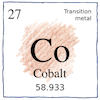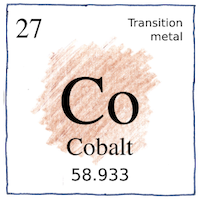Stockholm—Georg Brandt
elements

|
Cobalt
Egypt, Persia, Pompeii, and the Tang and Ming dynasties in China had blue glass, glasses, and ceramics but hadn’t isolated the metal whose compounds gave them the blue. Georg Brandt, warden of the Royal Mint of Sweden, showed cobalt was a metal and the blue color in glass was from cobalt not bismuth.
Atomic number 27
Miners called it “goblin stuff” because the ore always contained arsenic and was useless. Try to smelt it, you get toxic fumes of arsenic oxide and cobalt oxide, a useless powder instead of metal. * Superalloys of cobalt with nickel, tungsten, chromium, titanium make turbine blades and knee replacements. The cathodes of lithium-ion batteries contain cobalt, nickel-cadmium, nickel metal hydride batteries also contain cobalt. Blend with aluminum for cobalt blue, with zinc for cobalt green, with tin for cerulean blue, with phosphate for cobalt violet.
Stuff that jinxes
It’s not that you couldn’t but that you won’t try. It’s all in your head, if you think they’re out to get you. It’s useless or harmless, as far as you know, but what do you know? Answers won’t come until it’s too late. They say that what you don’t know won’t hurt you, but what about the witches stirring their pot in the woods? Don’t speak of the devil, though now it’s been done. Hear him knocking in the dark. Cross your heart and knock on wood. You can’t tell he’s not here. You just can’t see him— a little green man dressed in rags and making things go awry.



Other chemists disputed Georg Brandt’s claim that cobalt was an element, asserting that he merely had a compound of iron and arsenic. Maybe it was easy to dismiss his claims, given the metal had a name that translates as “goblin.”
See also in The book of science:
Readings in wikipedia:
Other readings: